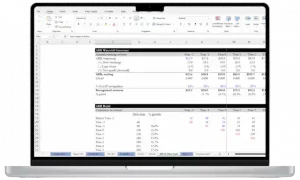What is investment banking in simple terms?
An investment banker helps companies, governments, or other clients raise capital. There’s lots of jargon around the industry, but that’s really what it comes down to.
Investment banks can help their clients raise capital in the form of debt (e.g. bonds, loans, etc.) or equity (e.g. IPO, strategic investments, M&A, etc.)
There are many types of investment banks — both bulge bracket (e.g. Goldman Sachs and JP Morgan) and boutique (e.g. Houlihan Lokey and Lazard). There are also regional or specialized banks who tend to focus on particular groups of clients (e.g. geographical or by industry).
How do investment bankers make money
Investment bankers make money through fees from corporate clients who pay them for either strategic advice or financial services.
Investment banks provide strategic advice to companies (i.e. their Board of Directors and management team) about potential mergers and acquisitions. Let’s say Uber wanted to merge with Lyft, Uber would likely hire an investment bank to advise them on the wisdom (and financials) of this move. Lyft would hire one as well, as they consider the potential deal. In these cases, investment banks are typically paid a percent (i.e. 2%) of the total deal value, if it is actually consummated.
Meanwhile, investment banks also provide financial services to companies, which means they assist the company in issuing debt or equity securities to investors. For instance, when a company wants to have an IPO (“go public”) they hire an investment bank typically to assist them.
As an underwriter of the deal, the investment bank would technically “purchase” equity shares from the company and then re-sell those shares to public market investors who’ve indicated interest ahead of time. On these (and similar debt issuances), the investment bank makes a percentage fee on the total deal value (e.g. ~5% for IPOs, 2-3% for debt issuances).
For more, here’s a detailed breakdown of each major revenue stream of investment banks.
Buyside vs. sellside
Buyside vs. sellside are terms that are often thrown around in the industry, but can be confusing to outsiders.
Here’s what you should know: the buyside refers to firms (e.g. private equity, hedge funds, growth equity) who purchase debt and equity securities, whereas the sellside refers to firms (e.g. banks) who sell and/or facilitate the issuance of those securities.
For instance, a “buyside” hedge fund might invest in an IPO that is being underwritten and facilitated by a “sellside” investment bank.
For a deeper explanation on buyside vs. sellside, check out this article.
Investment banking groups
There are many groups within an investment bank. They are typically divided into two groups: 1) product groups, 2) industry coverage groups.
The way to understand this is that product groups are specialists on certain services that are provided across every industry (e.g. M&A), whereas industry coverage groups are industry specialists who provide all products to clients in their industry (e.g. healthcare).
Here’s some examples of investment banking coverage groups includes:
- Financial Sponsors Group (FSG)
- Financial Institutions Group (FIG)
- Healthcare
- Technology, sometimes grouped as Technology, Media, and telecom
- Real Estate
- Industrials (incl. Transportation)
- Entertainment & Gaming
- Oil & Gas
- Consumer
- Infrastructure
- Energy (incl. Power, Utilities, Renewables, Metals & Mining, Chemicals)
Examples of investment banking product groups includes:
- Leveraged Finance (LevFin)
- Mergers & Acquisitions (M&A)
- Debt Capital Markets
- Equity Capital Markets
- Restructuring
Every bank organizes itself a little differently, so use above as a guide. Also, not every bank will decide to “cover” all industries or products, so some banks will have gaps.
Below I will provide a provide more detail on a few prominent groups to be aware of.
Mergers & Acquisitions investment banking group
The Mergers & Acquisitions (M&A) group is one of the most prominent and in-demand groups within an investment bank.
This group provides strategic advise to corporate clients who are considering purchasing (or being purchased by) another company.
The group is very attractive to young hires because you’ll go deep into financial modeling, you’ll work on high profile deals, and you’ll learn a ton. Traditionally, this group is one of the feeders into careers in private equity and growth equity firms for this reason.
Here’s a closer look at M&A investment banking groups.
Financial Sponsors Group
A financial sponsors group is a team within an investment banking division of an investment bank that advises alternative asset managers, including pension funds, hedge funds, sovereign wealth funds, and private equity firms.
These groups specialize in helping investors find and acquire companies while offering advisory services to help portfolio companies execute financing transactions.
Financial sponsors groups mainly work with private equity firms and other specialized investment firms but do not cover venture capital firms as their deal sizes are small
On the other hand, financial institutions groups work with insurance companies, banks, and other financial institutions, providing financing, advisory services, and other services such as helping them to raise capital and manage assets.
The deals that a financial sponsors group typically works on include leveraged buyouts, high-yield debt insurances, recapitalizations, new acquisitions, and sell-side mergers and acquisitions.
Although similar to a financial institutions group, financial sponsors groups differ in their focus and types of clients they deal with.
If you’re interested to know more about FSG, check out my full article on Financial Sponsors Group.

- 24 lessons
- 6+ video hours
- Expert instructor
ONLINE COURSE
Assess Business Models Like An Investor
Designed for aspiring private equity, growth, or venture investors
Technology investment banking group
The Technology investment banking group is one of the most interesting and popular groups in investment banking right now.
Of course, it’s not hard to see why. Technology companies and startups have grown in size and cultural appeal. Now there are incredible investment banking fees to be had by servicing huge tech giants like Apple, Netflix, Meta, and Amazon.
Also, from a career perspective, this group can be an incredible way for analysts and associates to learn about an industry that they may someday want to join (e.g. as a founder, a startup employee, or venture capitalist).
To go deeper, read my article on technology investment banking groups.
Leveraged Finance investment banking group
The Leveraged Finance investment banking group is perennially one of the most desirable groups to join within an investment bank.
That’s because this group is responsible for all transactions involving high debt amounts. This includes leveraged buyouts (including debt refinancings of existing leveraged buyouts).
Given this purview, this group is frequently interacting with private equity firms, which makes it highly desirable to young investment bankers. Also, given the nature of these transactions, Leveraged Finance bankers get to really learn how complex financial models really work.
To learn more, read my article on Leveraged Finance investment banking groups.
Investment banking career path
The investment banking career path can be very exciting and rewarding. One of the best parts about it is you work with very smart and driven people. There’s also typically a strong culture of high achievement at investment banks. These are things to factor into your thinking about why investment banking might be right for you.
I’ve long said that investment banking is one of the best and most impressive things that young folks can do right out of undergrad. There’s almost no other job where you get so much responsibility from such a young age. Of course you have bosses and people checking your work, but to be running the financial model for a multibillion deal is a pretty cool experience as a 22 year old!
The typical leveling for career paths within investment banks is as follows:
- Analyst
- Associate
- Vice president
- Director
- Managing Director
- Partner
Different firms will have slightly different hierarchies, but this gives you the main idea.
Here’s my deep dive article on investment banking career paths if you’d like to read further.
Investment banking hours
As an investment banker, you will work very long hours — e.g. anywhere between 60-100 hours/week is not unusual.
The industry has long had a culture of working hard. This is in part driven by the high fees, which drives a competitive desire to win, but also the high competition from other banks. All the banks are essentially competing to work on the same deals, which means that one way to differentiate yourself and “win the deal” is by working harder for and being more responsive than your competition to your clients.
The hours tend to be longest for more hires (e.g. analysts and associates), but even at senior levels, one must be ready to log long hours if the situation calls for it.
As a former investment banker, I’ve often said the hardest part of the hours was the unpredictability. Often, the length of the hours were fine — I didn’t mind working hard. What was difficult was the fact that it was hard to plan when you might be called back into the office at any point.
That said, the long hours also have a bonus — you get the chance to really perfect your skills. Anything you put so much time into you will learn really well. I wouldn’t want to do it again, but I truly cherish my own experience as an analyst because I learned so much in such a short amount of time!
Also, long hours creates the opportunity to make friends and bond with your colleagues (hopefully you like them!).
Here’s a full discussion of investment banking hours and my take on it.
Best schools for investment banking
While it’s not impossible to land an investment banking job from other schools, many top banks focus their recruiting efforts on a select few undergrad schools for new hires.
This list will depend widely by bank, often centering on the former schools of the firm’s senior bankers. However, in general, there are large recruiting efforts at these top schools for undergrad analyst hiring:
- All Ivy League schools (e.g. Princeton, Harvard, Yale, Cornell, etc.)
- Georgetown
- Stanford
- MIT
- Berkeley
- University of Chicago
Investment banking hiring at the MBAs tends to focus on top 20 business schools (e.g. Stanford, Wharton, HBS, Cornell, Booth, Tuck, etc.)
Investment banking exit opportunities
In a twist of irony, one of the biggest perks of being in investment banking is all the great opportunities you get to LEAVE investment banking ?
Because the training, skills, and rigor of these jobs is widely known, many employers find investment banking vets very attractive.
It’s quite common for young analysts (and even associates) to leave investment banking for:
- Private equity firms
- Technology private equity firms
- Growth equity firms
- Venture capital firms
- Hedge fund frims
- Startups
- Entrepreneurship/founder roles
- Business development roles
- Corporate development roles
At the more senior levels, folks tend to be on the “career track” so it’s less common to leave. However, when folks do, one common exit is to leave for high ranking financial jobs within clients (e.g. CFO).
Read my in-depth profile of investment banking exit opportunities for more.


 Break Into Growth Equity
Break Into Growth Equity

